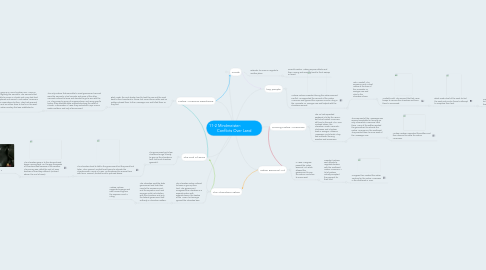
1. Moving Native Americans
1.1. The US had expanded westward a lot by the 1830's, but lots of Native Americans still lived in the East. The "Five Civilized Tribes" the Cherokee, Creek, Seminole, Chickasaw, and Choctaw, lived in Georgia, Alabama, Mississippi, and Florida. They had successful farming societies and economies.
1.1.1. The area west of the Mississippi was seemed unsuitable for farming, so only a few white Americans lived there. Many of the settlers wanted the government to relocate the Native Americans in the Southeast. They wanted them to move west of the Mississippi river.
1.1.1.1. Andrew Jackson supported the settlers and their demand to move the Native Americans.
2. Indian Removal Act
2.1. In 1830, Congress passed the Indian Removal Act, which allowed the government to pay the Native Americans to move west.
2.1.1. President Jackson sent officials to negotiate treaties with the Southeast Native Americans. A lot of Natives actually accepted the payment for their land.
2.1.1.1. Congress then created the Indian Territory for the Native Americans in the Southeast in 1834.
3. The Cherokee Nation
3.1. The Cherokee Nation refused to leave or give up their land. The government recognized the Cherokee as a separate nation with separate laws in the treaties of the 1790's, but Georgia ignored the Cherokee laws.
3.1.1. The Cherokee sued the state government and took their case to the Supreme court, and the Supreme court said Georgia could not interfere with the Cherokee, and only the federal government had authority in Cherokee matters.
3.1.1.1. Andrew Jackson supported Georgia and said he would ignore the Supreme Court's ruling.
4. key people
4.1. Andrew Jackson-President during the Indian Removal Conflict. He supported the removal of the Native Americans and ignored the Supreme Court's ruling in the Worcester vs. Georgia case and helped with the Cherokee removal.
4.1.1. John Marshall- The Supreme Court's Chief Justice at the time of the Worcester vs. Georgia case and ruled in the Cherokee's favor.
4.1.1.1. Winfield Scott- The General that led 7,000 troops to remove the Cherokee and force them to move west.
4.1.1.1.1. Black Hawk-Chief of the Sauk, he led the Sauk and Fox to Illinois to attempt to recapture their land.
5. vocab
5.1. Relocate- to move or migrate to another place.
5.1.1. Guerrilla Tactics- Making surprise attacks and then running and escaping back to the/a swamp or forest.
6. Native American Resistance
6.1. Black Hawk, the Sauk leader, tried to lead the Fox and the Sauk back to their homeland in Illinois, but 4,500 Illinois militia and US soldiers chased them to the Mississippi river and killed them as they fled.
6.1.1. The only Natives that were able to resist government removal were the Seminole. Chief Osceola and some of the other Seminole refused to leave and decided to go to war with the US. They joined a group of runaway slaves, and using guerilla tactics, they attacked white settlements along the coast of Florida. In December of 1835, they ambushed Major Francis Dade's soldiers, and only a few survived.
6.1.1.1. The government gave up in 1842, by when over 1,500 US soldiers had died fighting the Seminole. The Seminole that remained were able to remain in Florida. But many had died in the wars, or captured and moved. Most Native Americans lived in the west in reservations by then. They had received 68 million dollars and 32 million acres to live on in the west. They lived in the Indian Territory that was established in 1834.
7. The Trail of Tears
7.1. The government got a few Cherokee to sign a treaty to give up the Cherokee's land, but most Cherokee ignored it.
7.1.1. The Cherokee tried to talk to the government but they would not listen. Then General Winfield Scott came to relocate the Cherokee with a army of 7,000. He threatened to remove them with force. General Winfield Scott is pictured above.
7.1.1.1. The Cherokee gave in to the demands and began moving west. On the way, thousands of Cherokee died because of the weather. The journey was called the Trail Of Tears because of how they suffered. (Pictured above: the Trail of Tears)
7.1.1.1.1. The Trail Of Tears

